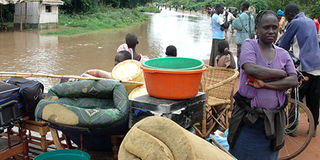Floods destroy Sh10m rice crop

Jacob Owiti | NATION
Villagers in Siaya move to temporary centres after they were uprooted from their homes by flood waters from River Nzoia. The government and other aid agencies are rushing to assist up to 40,000 people displaced across the country.
What you need to know:
- Officer drowns in swollen river as he pursues cattle thieves
An Administration Police officer drowned while 240 tonnes of harvested rice and 1,000 acres of the crop were destroyed as heavy rains continued to pound the country.
The officer was pursuing cattle thieves at South Ngariama ranch in Kirinyaga when he fell into the flooded River Nyamindi at the weekend.
The death of the corporal, who was was based at Ikulungu AP camp, brings to 15 the number of people who have drowned since the rains started a month ago.
District Commissioner Kula Hache sought help to retrieve his body.
The rice crop was destroyed in Busia’s Bunyala Irrigation Scheme after River Nzoia burst its banks.
The extent of the damage has left many farmers counting their losses and staring at the possibility of hunger.
Water and Irrigation permanent secretary David Stower, who led a government team to assess the situation, said the damage to crops was severe.
The number of displaced people is still rising, he said, adding that eight camps had been set up in Bunyala and Siaya to house them.
The PS said the government had sent three water tankers and 10 collapsible reservoirs as well as chemicals for treating water in the affected areas. The Ministry of Special Programmes was making arrangements to send relief food.
Mr Stower said a dam will be built along River Nzoia to end the perennial flooding problem in Budalang’i and Siaya.
Bunyala Irrigation Scheme manager Joel Tanui told the Nation that the rice had been packaged in 80kg bags ready for the market.
“Unlike in the past, the epicentre of the floods is right inside the scheme which is responsible for this damage,” Mr Tanui said.
The destroyed crop was due for harvesting in January.
A bag of rice is selling at Sh3,360 which means the 3,000 bags would have fetched the farmers Sh10 million.
Up to 40,000 people have been displaced in various parts of the country by the floods in the last month.
Prof Bancy Mati, who coordinates the System of Rice Intensification (SRI) project, warned that rice growing areas affected by floods would plunge into hunger unless immediate measures were taken.
In Isiolo, hundreds of acres of farms in Sericho, Gafarsa and Eres Sabur have been swept away by flood waters, after the Ewaso Nyiro River, burst its banks two weeks ago.
The floods destroyed the main pipeline that supplies water to Sericho Centre, the borehole and many pit latrines, exposing residents to waterborne diseases.
In Siaya, thousands of families continued to flock evacuation centres.
Kenya Red Cross Society regional manager Emanuel Owako estimated the affected families at 5,000 and more than 400 hectares of land submerged. More centres were being set up to accommodate the victims.
In Narok, the rains have damaged roads and bridges, paralysing transport.
Reports by Walter Menya, Abiud Ochieng’, George Munene and George Sayagie




